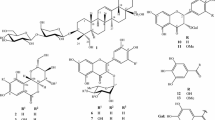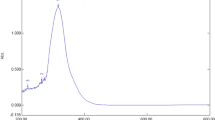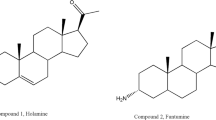Abstract
The study was aimed at exploring cytotoxic activity of Oldenlandia umbellata and its chemical constituents. Cell viability assay of crude methanolic extract of aerial parts of O. umbellata (HUM), its ether soluble fraction (HUM-E) and butanol soluble fraction (HUM-B) against colon cancer HT-29, lung epithelial A549 and breast adenocarcinoma MDA-MB-231 cell lines showed HUM-E to be significantly cytotoxic with IC50 values of 25.7, 67.7 and 69.3 μg/mL, against HT-29, A549 and MDA-MB-231, respectively. Chemical investigation of HUM-E and HUM-B resulted in the isolation of a novel symmetrical coumarin dimer named oledicoumarin (1), together with eleven known compounds, hedyotiscone B (2), cedrelopsin (3), pheophorbide A methyl ester (4), deacetyl asperuloside (5), scandoside methyl ester (6), asperulosidic acid (7), scandoside (8), nicotinic acid (9), 6α-hydroxy geniposide (10) anthragallol 1,2-dimethyl ether (11) and anthragallol 1,3-dimethyl ether (12). All compounds were isolated for the first time from O. umbellata except anthragallols. This is the foremost report exploring the presence of coumarin derivatives in O. umbellata. Testing of cytotoxicity of isolated constituents revealed that compounds 3, 4, 11 and 12 showed significant inhibition against A549 cells with IC50 values of 3.6–5.9 μg/mL. Compounds 4, 11 and 12 showed marked inhibitory effect against MDA-MB-231 cells (IC50 3.6–9.1 μg/mL). Compounds 4 (IC50 1.7 μg/mL) and 7 (IC50 6.1 μg/mL) were highly active against HT-29 cells. In summary, the less polar fraction of O. umbellata and its constituents were found to be cytotoxic.



Similar content being viewed by others
References
Banthorpe DV, White JJ (1995) Novel anthraquinones from undifferentiated cell cultures of Gallium verum. Phytochemistry 38:107–111
Chen YH, Chang FR, Wu CC, Yen MH, Liaw CC, Huang HC, Kuo YH, Wu YC (2006) New cytotoxic 6-oxygenated 8,9-dihydrofurocoumarins, Hedyotiscone A–C, from Hedyotis biflora. Planta Med 72:75–78
Cheng HH, Wang HK, Ito J, Bastow KF, Tachibana Y, Nakanishi Y, Xu Z, Luo TY, Lee KH (2001) Cytotoxic Pheophorbide related compounds from Clerodendrum calamitosum and C. cyrtophyllum. J Nat Prod 64:915–919
Ferlay J, Soerjomataram I, Dikshit R, Esr S, Mathers C, Rebelo M, Parkin DM, Forman D, Bray F (2014) Cancer incidence and mortality worldwide: sources, methods and major patterns in GLOBOCAN 2012. Int J Cancer 136:E359–E386
Fraga BM, Quintana N, Diaz CE (2009) Anthraquinones from natural and transformed roots of Plocama pendula. Chem Biodivers 6:182–192
GLOBOCAN (2012) Estimated cancer incidence, mortality, and prevalence worldwide in 2012. http://globocan.iarc.fr/Pages/fact_sheets_cancer.aspx. Accessed 15 Feb 2015
Guvenalp Z, Kilic N, Kazaz C, Kaya Y, Demirezer LO (2006) Chemical constituents of Galium tortumense. Turk J Chem 30:515–523
Hema V, Venkidesh R, Maheswari E (2007) Antitussive activity of Oldenlandia umbellata. Int J Chem Sci 5:2480–2484
Hema V, Vasudev A, Prameela RA (2009) Phytochemical screening of Oldenlandia unbellata. Int J Chem Sci 7:2096–2102
Kamiya K, Fujita Y, Saiki Y, Hanani E, Mansur U, Satake T (2002) Studies on the constituents of Indonesian Borreria latifolia. Heterocycles 56:537–544
Lopes S, Poser GLV, Kerber VA, Farias FM, Konrath EL, Moreno P, Sobral ME, Zuanazzi JAS, Henriques AT (2004) Taxonomic significance of alkaloids and iridoid glucosides in the tribe Psychotrieae (Rubiaceae). Biochem Sys Ecol 32:1187–1195
Malaya G, Mazumder UK, Thamilselvan V, Manikandan L, Senthilkumar GP, Suresh R, Kakotti BK (2007) Potential hepatoprotective effect and antioxidant role of methanol extract of Oldenlandia umbellata in carbon tetrachloride induced hepatotoxicity in wistar rats. Iran J Pharmacol Ther 6:5–9
Mukaiyama T, Funasaka S (2007) Pyridine-3-carboxylic anhydride (3-PCA): a versatile, practical, and inexpensive reagent for condensation reaction between carboxylic acids and alcohols. Chem Lett 36:326–327
Padhy IP, Endale A (2014) Evaluation of anti-inflammatory and anti-pyretic activity of Oldenlandia umbellata Linn. roots. Int J Pharm Healthc Res 02:12–14
Patre RE, Parameswaran PS, Tilve SG (2011) Synthesis of the naturally occurring prenylated coumarins balsamiferone and cedrelopsin by domino reactions. ARKIVOC 9:68–76
Purushothaman KK, Saradambal S, Narayanaswami V (1968) Isolation and identification of some anthraquinone derivatives from Oldenlandia umbellata. Leather Sci 15:49–51
Ramamoorthy S, Gaurav M, Rajesh D, Nawaz KF, Vijayakumar V, Rajasekaran C (2009) Characterization of novel pH indicator of natural dye Oldenlandia umbellata L. Nat Prod Res 23:1210–1217
Rekha S, Srinivasan V, Vasanth S, Gopal RH (2006) In vitro antibacterial activity of Hedyotis umbellata. Indian J Pharm Sci 68:236–238
Rho MC, Chung MY, Song HY, Kwon OE, Lee SW, Baek JA, Jeune KH, Kim K, Lee HS, Kim YK (2003) Pheophorbide A-methyl ester, Acyl-CoA: cholesterol acyltransferase inhibitor from Diospyros kaki. Arch Pharm Res 26:716–718
Sethuramani A, Jagadeesan M, Kavimani S (2014) Antitumor activity of ethanolic and aqueous extract of Oldenlandia umbellata and Oldenlandia corymbosa against Dalton’s Ascitic Lymphoma in mice. Int J Biol Pharm Res 5:150–155
Shao J, Gong G, Trombetta L (2011) An evidence based perspective of Hedyotis diffusa or Oldenlandia diffusa (spreading Hedyotis) for cancer patients. In: Cho WCS (ed) Evidence based anticancer material medica. Springer, Berlin, pp 179–192
Simonsen HT, Adsersen A, Bremner P, Heinrich M, Smitt UW, Jaroszewski JW (2004) Antifungal constituents of Melicope borbonica. Phytother Res 18:542–545
Sivaprakasam SSK, Karunakaran K, Subburaya U, Kuppusamy S, Subashini TS (2014) A Review on phytochemical and pharmacological profile of Hedyotis corymbosa Linn. Int J Pharm Sci Rev Res 26:320–324
Sowemimo A, Venter MVD, Baatjies L, Koekemoer T, Adesanya S, Lin W (2012) Cytotoxic compounds from the leaves of Combretum paniculatum Vent. Afr J Biotechnol 11:4631–4635
Toyoda K, Yaoita Y, Kikuchi M (2005) Three new dimeric benzofuran derivatives from the roots of Ligularia stenocephala MATSUM. et KOIDZ. Chem Pharm Bull 53:1555–1558
Wijnsma R, Verpoorte R, Mulder-Kieger T, Svendsena AB (1984) Anthraquinones in callus cultures of Cinchona ledgeriana. Phytochemistry 23:2307–2311
Yoganarasimhan SN (2000) Medicinal Plants of India. Vedams Books (P) Ltd, Bangalore
Zhu L, Li H, Liang Y, Wang X, Xie H, Zhang T, Ito Y (2009) Application of high-speed counter-current chromatography and preparative high-performance liquid chromatography mode for rapid isolation of anthraquinones from Morinda officinalis How. Sep Purif Technol 70:147–152
Acknowledgments
We thank Ms. Satsuki Itoh, Tokyo Institute of Technology, for her measurements of FABMS. Author S. Mahibalan thanks Council for Scientific and Industrial Research, New Delhi, India, for granting Senior Research Fellowship (F. No. 09/1026(0005)/2012). Authors also acknowledge Research Initiation Grant from BITS-Pilani Hyderabad, Telangana State, India.
Author information
Authors and Affiliations
Corresponding author
Ethics declarations
Conflict of interest
No authors have any conflicts of interest to declare.
Ethical statement
Prior approval from Institutional Biosafety Committee was obtained to carry out cytotoxicity study.
Rights and permissions
About this article
Cite this article
Mahibalan, S., Rao, P.C., Khan, R. et al. Cytotoxic constituents of Oldenlandia umbellata and isolation of a new symmetrical coumarin dimer. Med Chem Res 25, 466–472 (2016). https://doi.org/10.1007/s00044-015-1500-z
Received:
Accepted:
Published:
Issue Date:
DOI: https://doi.org/10.1007/s00044-015-1500-z




